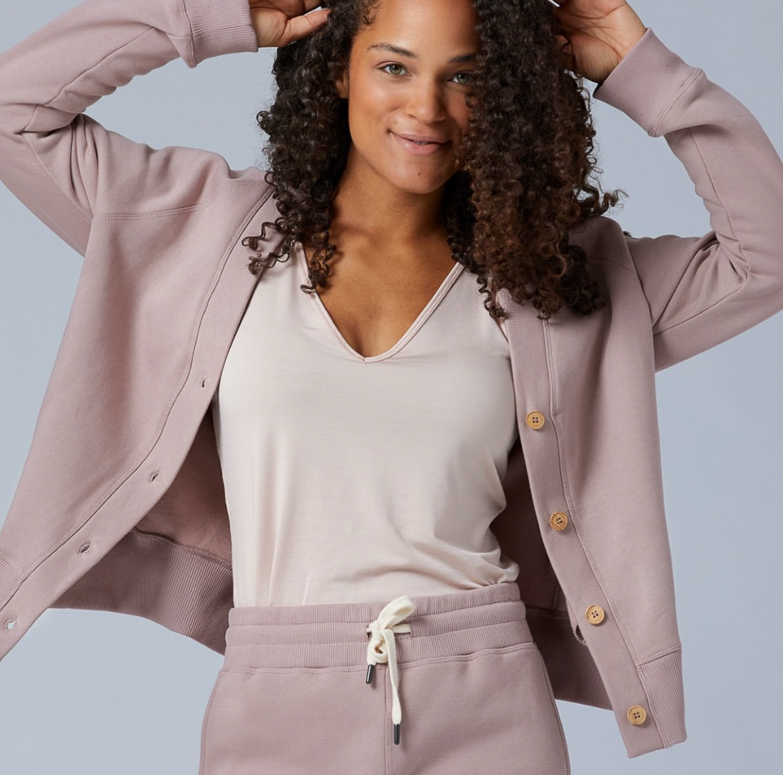
Meet Cass from Hernest Project. I have had the pleasure of working with Cass as a model and collaborating together on style content. I first fell in love with her brand back in 2019. The softness of the fabrics, the ease of wear, and the classic designs that felt very modern and timeless. What wasn’t to love? I now have several pieces of Hernest in my wardrobe. Some for sleep. Some for day to day life. All well worn and well loved.
Cass started Hernest because she couldn’t find beautiful, functional, sleepwear that could double as loungewear that was also good for the planet.
Hernest does things differently. Cass has reimagined a future where businesses thrives within the constraints of the planet and supports resilient communities. Sustainability is at the core of every piece, every detail and it is central to everything they do.
Let’s get to know Cass more.
1. You have been able to perfectly blur the lines between PJ’s and loungewear and I’m here for it. What made you decide to create this category of clothing?
The idea really started after we moved to Germany. I was home with my 1 and 2-year-olds and trying to navigate the day with sanity and enthusiasm. Between early mornings (like 5 am every day with my son), early bedtimes and lots of time spent kneeling and reading books, and making snacks, I felt like I wanted better “house clothes.” Putting on make-up and getting dressed for the day wasn’t really my style, to begin with. I knew that wasn’t what I needed to make me feel “better.” I’ve always been jeans and tee girl, but jeans and tees aren’t that comfortable at home. Anyway, that year I asked my husband for a “nice” set of PJs for Christmas. Something I can move in, won’t make me sweat and has no synthetics. I said I need to be able to wear these all day if I have to… needless to say what I got wasn’t what I had in mind.
That’s when the wheels started turning. Throughout my “career,” I had written a number of business plans, and I had also worked in the apparel industry for 6 years… At first, it didn’t feel like big a stretch for me to start doing research and getting ideas together. Because we were in a new country and I didn’t know anyone and had some spare time to make enquiries – and I had no one telling me i was crazy… things started falling into place and I just kept taking small steps. It took 2.5 years of research on sustainable manufacturing and fabrics, and prototyping to land on 5 initial styles in a few colours which I then sent to 35 arm’s length (and a few non-arms length) people to test. The results of the inital test were amazing & the day I paid an agency A LOT of money to do my branding, I knew I had to make everything else happen.

2. Ethically made clothing has a price that reflects responsible fabrics, paying living wages and more. What is your approach to educate your customers or potential customers about price when you get the “It’s so expensive” comments?
I‘m not going to lie, this is hard. I look around at the prices brands are charging (both ethical and not-so-ethical), and to me, it’s so obvious that we’ve lost sight of value. Consumers are actually the ones paying for the marketing and the fancy campaigns we’re being sold by big brands, and being told what’s cool and what’s not so cool by celebrities and we’ve lost sight of what our clothes are made of and who is making them… and what value they hold.
I write blogs that share the costs of garments, I create reels and I have a lot of conversations. I do wish I was more articulate in this area! My ultimate “goal” I guess is for people to feel like they made a worthwhile purchase and that I influenced or evolved their experience with “slower” fashion through their interaction with Hernest.

3. What is something about your slow fashion business you wish more people knew?
I wish it was easier for people to understand that slow fashion / ethical fashion / sustainable fashion (whatever words people associate with fashion that’s created with purpose) is the whole package. Considered design, slow processes, considered fabrics, and ethical supply chains, sustainability goals, more inclusive sizing, etc (I’m sure i’m forgetting something). It’s evolving and adaptable. There is no single best practice but there are “better” ways to do things. I wish people understood that it’s not a “constraint” / “hardship” to shop this way, BUT it’s actually quite liberating and joyful. I feel like slow fashion gives control back to the consumer in an ever-out-of-control world.

You can shop Hernest HERE and find them on Instagram at @hernestproject
The post Three Questions With Cass of Hernest Project appeared first on Jen Pistor.
